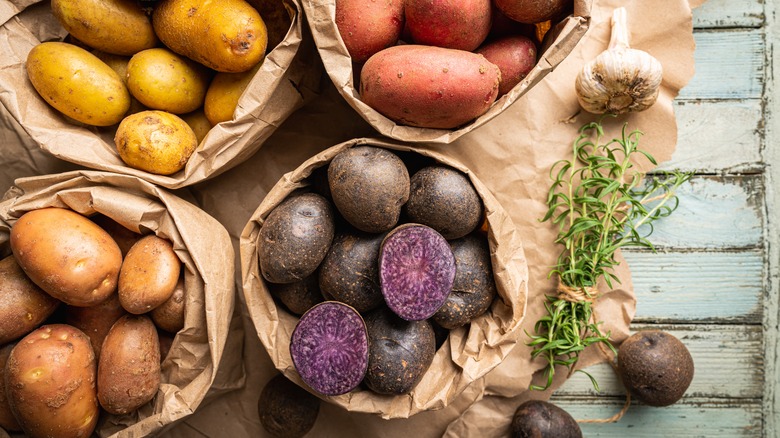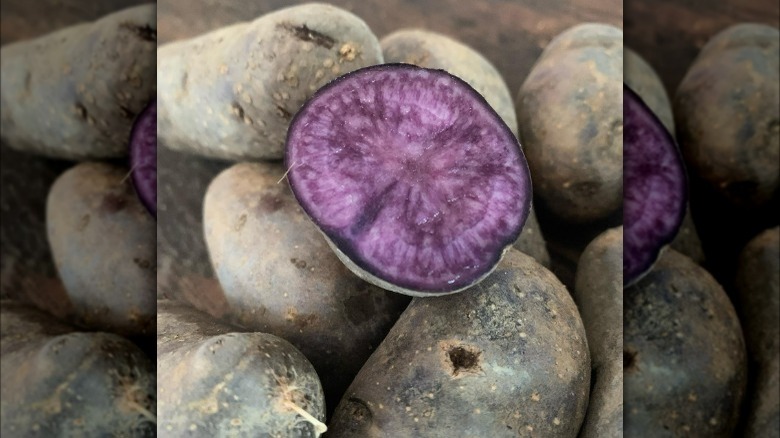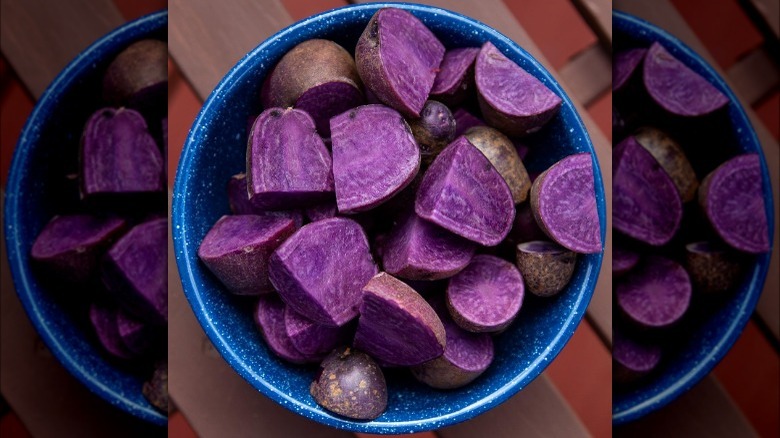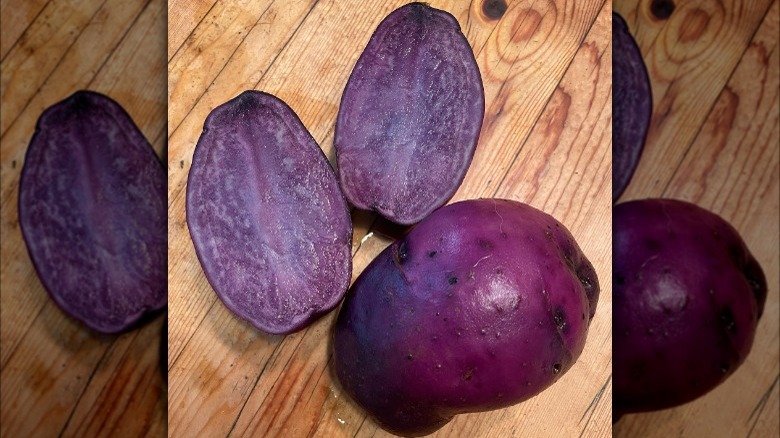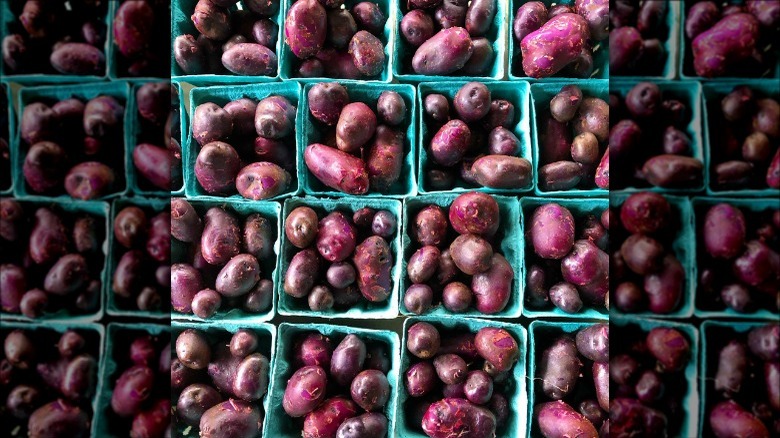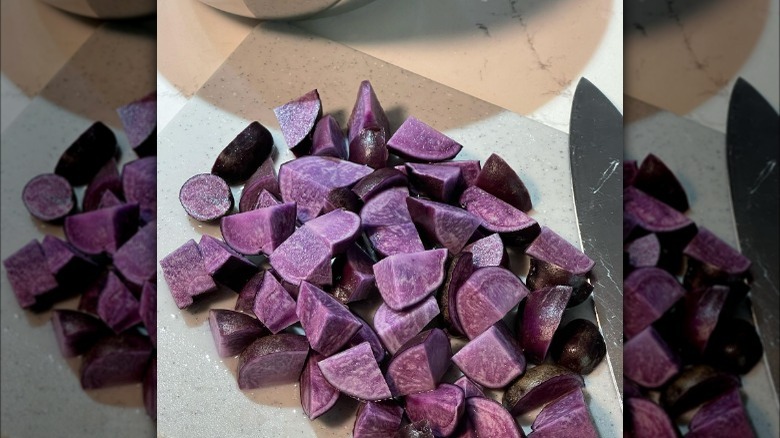Adirondack Blue: The Versatile Potato For Jewel-Tone Dishes
Potatoes are one of the most important, popular, and versatile crops worldwide, with the International Potato Center noting that they are right behind rice and wheat in the ranking of most consumed foods. The tuberous vegetable was cultivated by the Incas anywhere from 8000 B.C. to 5000 B.C. and was brought to Europe by the Spanish in the mid-16th century, according to Potatoes USA.
There are more than 200 reported varieties of potatoes, divided into seven categories. Russet, red, white, and yellow potatoes are most commonly found in grocery stores and can be used for any number of delicious potato-based recipes, from french fries to mashed potatoes, hash browns, latkes, and more. Fingerling and petite potatoes are more delicate and preferred when emphasizing presentation.
Purple potatoes, though, combine the versatility of larger varieties with the decorative aspect of your plate, adding a pop of color. One stunning purple potato variety is Adirondack blue, a rich purple potato on the inside and out that can be prepared in a variety of delicious ways.
What are Adirondack blue potatoes?
Adirondack blue (solanum tuberosum) potatoes are a relatively new cultivar, with Fedco Seeds reporting that they were released in 2003 by specialists in potato genetics at Cornell University. The same group also released the Adirondack red, Keuka gold, and Yukon gem varieties. Though they're called blue, they have a very distinct, dark, rich purple shade both inside and out, and it stays just as vibrant when cooked, unlike other purple potatoes that tend to lose pigment.
That purple pigment is called anthocyanin and it loads the potatoes with antioxidants. It's considered a mid-season potato, meaning seeds will turn into spuds in 80 to 90 days. In terms of planting, Johnny's Selected Seeds says to sow the tubers starting in early spring. They prefer growing in well-draining soil and can handle light bouts of frost when first planted. The potatoes grow well in New York state, as well as other cold climates, per The New York Times.
What do Adirondack blue potatoes taste like?
Adirondack blue potatoes don't just look different from other potato varieties, but they have a slightly varying texture and even application in cooking. According to Michelin Guide, the potatoes have a dense texture and taste similar to Yukon gold potatoes.
While Adirondack blue potatoes are far from the only purple potato variety, they do stand out as one of the most vibrant — both before and after cooking. Other purple spuds have a tendency to lose pigment once cooked, even taking on a grayish hue, but Adirondack blue potatoes are heralded for how well they retain their color after being boiled, roasted, or fried, per Johnny's Selected Seeds.
Other potatoes simply have the color of Adirondack blue, and not necessarily the uniquely dense texture. Purple Peruvian potatoes, for example, are just as bright on the inside, but lighten to an indigo shade once cooked, explains FreshPoint. The outlet adds that their cooked texture is similar to Russet potatoes, which are a little fluffier than Yukon gold.
How to cook with them
Adirondack blue potatoes don't have a unique flavor profile, so if you're going to use them in place of any other potato variety, it should be to highlight and showcase the stunning jewel-toned flesh. New City Neighbors recommends roasting, baking, or boiling them for this reason, as they retain their color the best this way.
If you want to add a pop of color to your dinner plate, the bright Adirondack blue potato is a perfect choice. Michelin Guide suggests pairing them with other vivid vegetables, like bright green broccoli, or even romanesco for a colorful and texturally interesting dish.
The dense texture means it's also a great, and visually unique, mashing potato. Or, you could follow the advice of This Healthy Table, and top freshly roasted Adirondack blue potatoes with bright green herbs like parsley and basil for a vibrantly delicious meal. They also state that the spud's skin is quite thin, so there's no need to peel it.
Where to buy Adirondack blue potatoes
It's not likely that you'll find Adirondack blue potatoes at your local grocery store, as they're more of a homegrown variety. If you want to find fresh, full grown potatoes, try local farmers markets. However, the more reliable course of action is to buy seed potatoes online and grow them yourself.
There are plenty of online retailers that sell Adirondack blue seed potatoes at different weights and prices. Wood Prairie Family Farms sells anywhere from one-pound to 45-pound quantities, ranging in price from $15 to $135. These potatoes aren't ideal to eat, though. Seed potatoes are set aside to plant and grow new spuds, and as such, are treated a little differently than potatoes grown for eating.
As Backyard Digs explains, seed potatoes are not treated with sprout inhibitors. This leads to a better-growing potato, but it may be unsightly for consumption. They are, however, often treated with aggressive fungicides that make them unfit for eating, warns Brilliant Gardener. Only eat seed potatoes if you know exactly where they come from and what they were treated with.
Nutritional information
Potatoes in general tend to get a bad reputation in terms of health and nutritional benefit. In reality, the starchy tubers have a lot to offer. According to WebMD, potatoes are an excellent source of fiber, which helps keep you full, as well as regulate your cholesterol and blood sugar and prevent heart disease.
The skin also has lots of potassium and magnesium, which helps lower your blood pressure. The issue with potatoes lies largely in how they're prepared. If you're sensitive to fats, then heavy toppings like creams or cheeses can pose a personal health problem. Similarly, deep-fried potatoes, like french fries, tater tots, or hash browns should be consumed in moderation.
Adirondack blue potatoes are best consumed when boiled, roasted, or baked instead of fried, though. Their purple pigment also comes from anthocyanins, per Fedco Seeds. This flavonoid is also found in red cabbage, red onions, purple cauliflower, purple corn, cherries, black plums, black beans, and even wine (via Cleveland Clinic). Anthocyanins have strong antioxidant properties and are linked to heart health, lowering blood pressure, and preventing cancer.
